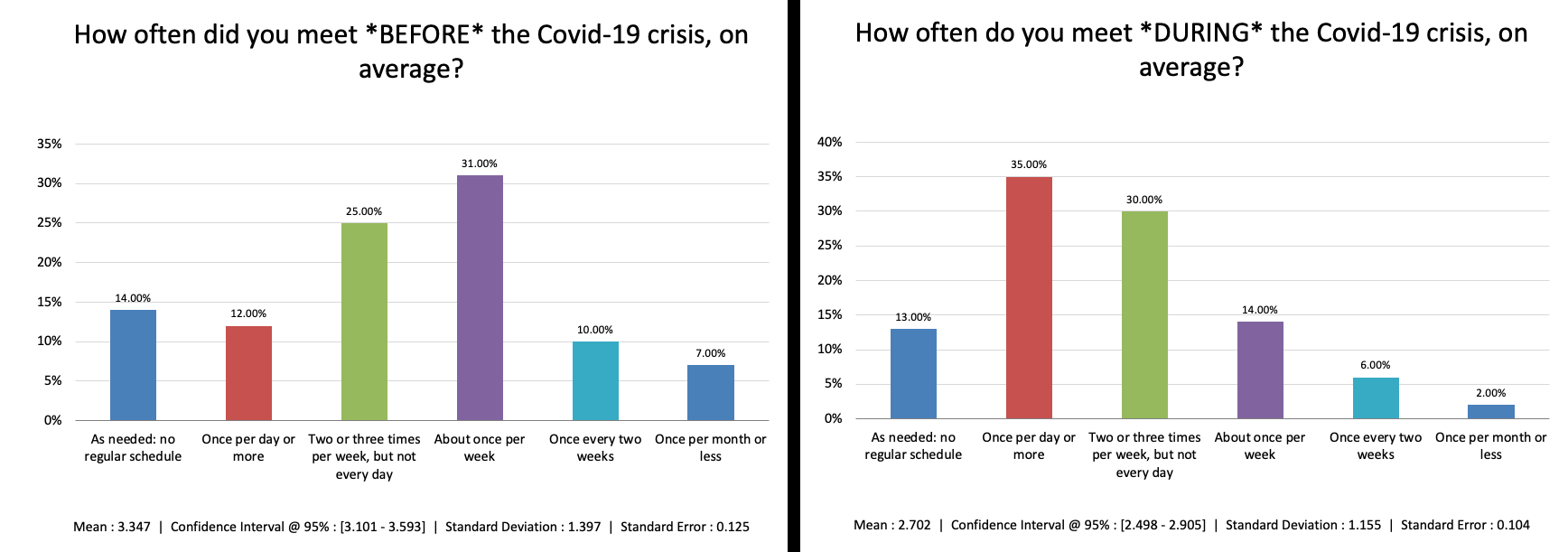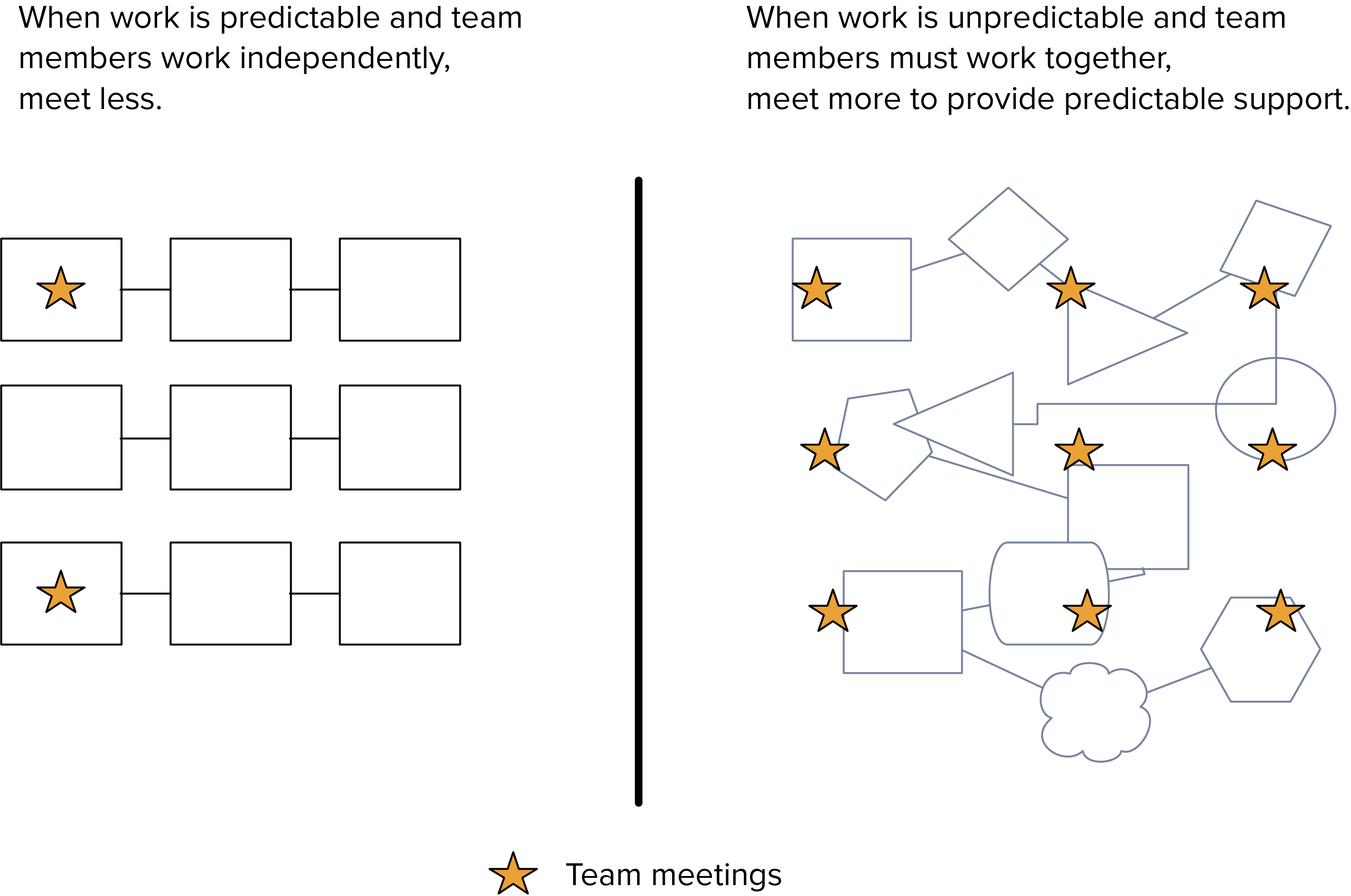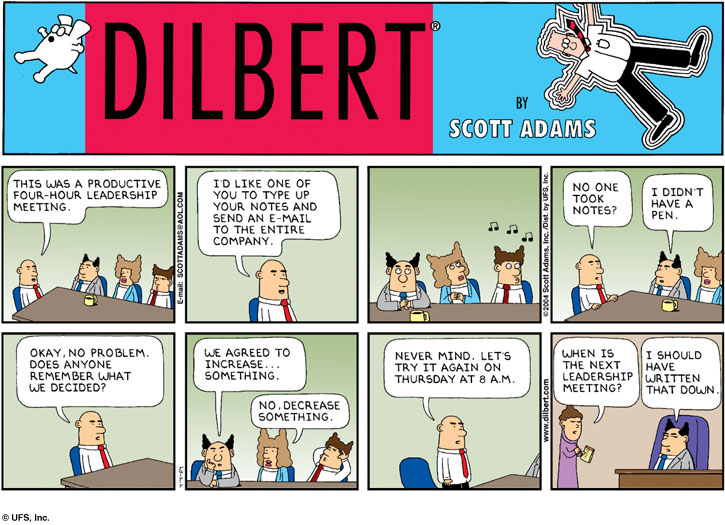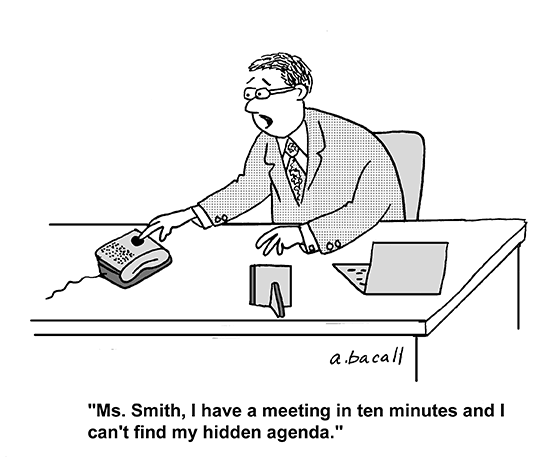How to Find the Most Productive Meeting Schedule for a Team Like Yours
Too much time wasted in unproductive meetings. This remains a top contender on the list of workplace complaints, as it has been for at least 700 years.
Some folks wrestling with this complaint assume that the solution is to simply reduce the amount of time spent in meetings, ideally through the elimination of as many meetings as possible. This is a tidy, easily measured approach, which can yield a quick claim to victory.

Others realize that this kind of victory just pushes the problem around. Short meetings are replaced by long email threads. Fewer meetings, but more project delays or quality issues. Squeeze out the meetings, only to see another part of your communication architecture poof out.
While there are many meetings that should have been an email, the goal is not to substitute an ineffective meeting with an ineffective email, or to switch out too much time wasted talking with too much time wasted gibbering at each other in Slack.
A better approach to reducing time wasted in unproductive meetings begins by seeking answers to these two questions:
- How many meetings are too many?
- How can we increase the ratio of productive vs. unproductive meetings?
These questions drive much of the research work we do here at Lucid. We’ve learned that the answers to both questions depend on the work you do and your role in the organization. You can see our earlier findings on this topic here:
Beyond your role and the nature of your work, the best meeting frequency (or cadence) for your team will also vary based on what’s happening in your organization’s operating environment.
The recent COVID-19 pandemic and subsequent economic shutdown shifted the operating environment for almost everyone all at once. This gave us an opportunity to see how this context change impacted meeting frequency across a variety of teams.
In April 2020, we ran a quick survey asking people to share how their meetings had changed in response to this shift.
The results? No surprises: meeting frequency increases when predictability drops.

During April 2020, 22% met weekly or less, and 65% met daily or more. See these charts larger.
These results align with what we’ve seen in practice and with long-standing industry recommendations. When your team is in a new situation–whether that’s because you’re a brand new team still figuring out how to work together or instead, you’re a well-established team whose normal ways of working have just been thrown into chaos–you need to schedule more frequent meetings to figure out what’s going on and what you’re going to do to stabilize your approach.
Two Primary Factors Drive the Optimal Meeting Cadence
Based on our own work, and building on the teamwork research conducted by Amy Edmondson and others, we believe there are two main factors you should consider when establishing your team’s meeting cadence.
- Independence vs. Interdependence: How much do the people in the group rely on one another to achieve their goals?
- Predictability vs. Uncertainty: How predictable is the work? If nothing ever changes, there’s nothing to talk about. If, on the other hand, your working environment is impacted by all kinds of complex and unpredictable goings-on, meet more.
Recommended Meeting Frequency Based on the Nature of the Work
How does this play out in practice?
We’ve talked with groups that meet just once per year because they must; it’s mandated by law. Otherwise, they wouldn’t bother. If there aren’t many surprises on the agenda and you don’t really care that much about what the other team members do (think of Homeowners Associations as an example), then you rarely need to meet. Meet often enough to maintain the group’s existence, or when you see an opportunity to do something fun together, but otherwise don’t bother.
At the other end of the spectrum, we spoke with one retired general who once had his teams run After Action Review meetings every 30 minutes during an especially intense training drill. Often in times of emergency, the group in charge of a coordinated response will keep their communication channels open all day. Think of the war rooms you see in movies, or mission command, and you’ll know what we’re talking about.
Teams with more interdependence between members need to meet more often. That interdependence can arise in response to a crisis, but for many, that’s also just the nature of their everyday work.
Software teams, where each person focuses on one part of the code or design before it all gets combined to deliver the final product, have high interdependence. The agile development ceremonies popular with software teams include daily meetings. By contrast, university professors working in the same department all teach different courses and run separate research projects. Professors rarely act as a team, have low interdependence, and require far fewer meetings.
Teams with highly predictable work rarely need to meet. Retail workers, delivery personnel, and many front-line workers complete the same kind of tasks on most days, so even though they may work in a fast-paced environment, they don’t need many meetings to stay on track.
Teams in highly uncertain environments, where the work constantly evolves, meet more often. Emergency responders, start-ups, product and project designers who are always navigating complex or uncertain situations need to meet more.
Let’s look at three teams all working in a related sector (health care) as a final set of examples. While they all work in the same segment of the workforce, they use different meeting cadences based on their operating context.
Example: A Private Dental Practice
Dental practice work is fairly predictable, with light interdependence between team members. While those involved operate as a team, their work is often serialized. The front desk handles scheduling and billing. The hygienist handles X-rays and cleaning. The dentist evaluates overall health and takes care of the big interventions, like fillings and implants. The front desk hardly ever steps in to help a patient floss, and while they happen, the range of dental surprises is constrained.
Given the relatively high predictability and low interdependence, most dental offices hold a single weekly business meeting where the team meets to discuss the schedule, any announcements concerning staff, updates to policies and procedures, and possibly solve some new problems or spend time team building.
Many dental office team meeting schedules look quite similar to the meetings held by leadership teams in manufacturing, services, and other businesses where the work remains fairly predictable from week to week.
Also like most businesses, dental offices will hold a series of meetings throughout the year to create and update their strategic plan, provide staff training, and ensure compliance with the rules and regulations that govern their practice.
Uncertainty: Low
Interdependence: Low
Meetings Dental Office Workers Can Expect:
- Weekly (or bi-weekly) staff meetings
- Regular certification and training sessions
- Quarterly and annual planning and strategy sessions
Example: An Emergency Room
Emergency room work isn’t so predictable. Some days are quiet, some off-the-hook busy. Sometimes they’re treating people who really should have been able to treat themselves at home, and sometimes they’re aiding victims of life’s most heartrending tragedies. To treat these patients, emergency rooms coordinate work between a team of specialists and generalists who communicate frequently as new situations develop.
Emergency departments hold meetings several times per day as part of every shift change. These stand-up shift change meetings are used to ensure the people beginning their work learn what’s going on from those who are ending their shift. Emergency department work is far less predictable than it is for dentists, but it’s not entirely chaotic. These professionals know the members of their team, the most common kind of emergencies they’ll face, the process for rapidly assessing and routing new patients, and the resources available to them in terms of equipment, personnel, and treatment capacity.
And, like the dental offices, the Emergency and ICU departments also have policy updates, staffing changes, and all the other business-level arrangements to manage, which they’ll discuss in weekly business update meetings.
Emergency room staff also run frequent after-action reviews (AARs) to evaluate a patient’s outcome and find ways to improve going forward. These meetings don’t follow as predictable a cadence, but they do all use a common meeting process.
On top of all the daily and weekly meetings, emergency room staff can expect to attend several meetings throughout the year designed to ensure their operational readiness. Disaster drills, trauma certification reviews, joint commission policy meetings, OSHA committees, harassment and self-defense training; there are a lot of predictable meetings to fit in.
Uncertainty: Moderate to High
Interdependence: High
Meetings Emergency Room Workers Can Expect
- Two or three times per day (once per every shift change), plus the weekly staff meeting
- AARs after some patient experiences
- Monthly functional team meetings in larger hospitals, like a meeting of all charge nurses or supervisors
- Regular certification and training sessions
Example: A Battlefield Medical Unit
Medical personnel operating on the front lines of a combat zone may have days that look similar to a domestic emergency department, and others where all heck rains down. These professionals have less predictability and more interdependence, as they may need to quickly switch roles and even pick up and move locations while treating a high volume of trauma patients.
In circumstances like these, the tidy shift change meetings go by the wayside. Instead, these professionals rely on a heightened stream of ritualized, procedural communication. Small teams form quickly over patients and rapidly communicate how they’ll proceed, which the dentists and emergency room people do as well but with less intensity. The best teams run more AARs, more rapidly; with 10 and 20-minute reviews that help them learn and adapt quickly to an emergent situation.
Frontline operators spend less time on policy and procedure meetings, training, or governance when on deployment. Most of these planning and oversight meetings occur in centralized command centers.
Uncertainty: Very High
Interdependence: Very High
Meetings Battlefield Units Can Expect
- Similar daily/weekly cadence to emergency rooms, to be replaced by short, frequent problem-solving and AAR meetings held directly before and after each action during times of crisis.
I’ve used examples from the medical world because they make it really easy to build a mental model of how degrees of predictability and interdependence influence meeting frequency. Now, apply this same framework to your own industry and consider how other teams with similar professional roles may benefit from very different meeting cadences.
Another example: software developers writing code for a Mars robot scheduled to launch 10 years from now can meet less often than software developers defending the U.S. electric grid from an active cyber attack. There is no one right meeting frequency for all software developers. Anyone who tries to convince you otherwise is being a bully.
Put it together, and it looks like this.

The more unpredictable and interdependent your work is, the more important a frequent, predictable meeting schedule becomes.
Said another way, if you can’t predict what will happen next, you’d better have a predictable plan for how you’ll work together to deal with it.
Meeting Frequency During Covid-19
In early 2020, predictability declined everywhere for everyone, and meeting frequency increased. This was true even for teams where the interdependence remained low.
Today, we’re still dealing with shuttered businesses, massive economic disruption, and low visibility into when or if something resembling business-as-usual can resume. Maybe never. And yet, a lack of predictability that persists becomes predictable; a more higgeldy-piggeldy status quo to be sure, but a status quo nonetheless.
You can see this shift beginning in some of the later survey replies. These replies came in at the end of April, which for some in our international audience was nearly four months into their lockdown.
As the situation stabilized, teams developed new meeting practices to help them navigate the world as it is now. With these practices providing a steady touchpoint, they can scale back their meeting frequency to more closely match the fundamental predictability and interdependence inherent in their work today.
Experiment to Fine-Tune Your Meeting Cadence
If you’ve read this and our other work on meeting cadence (see links below), you know that we believe there are a finite number of regular team meeting schedules that work well. Some teams need to meet more, some less.
With this article, I’m hoping you can see that the best-fit schedule for your team isn’t just a function of your industry or job title. Teams in similar lines of work, but operating in different environments, need different meeting schedules. And, as the COVID-19 shifts showed, the best meeting cadence for your team can and should change in response to changes in your operating environment.
So how do you find the schedule that works for you?
- Start with a schedule used successfully by a team doing work similar to yours.
- Ask your team to help you identify any meeting time they feel was unproductive, and change how those meetings work. Presuming you’ve found a reasonable cadence, here are a few other factors that lead to wasteful meetings.
- Measure your results and experiment.
When your team stops complaining about too much time wasted in unproductive meetings, and instead focuses on optimizing meeting time to increase performance, you’ve found your sweet spot.
As you experiment and learn more, please share your observations in the comments.
How do these factors play out for your group? What else influences your meeting success? What can you share with other teams like yours to speed up their journey? We’re all looking gratefully forward to learning more.
Related Articles
- Why meet? Understanding the Function of Meetings in the Collaborative Workplace
- How often should you meet? Selecting the right meeting cadence for your team.
- Meetings and Productivity: Driver or Drain?
- Why Meeting Flow Models are the Key to Unlocking Your Team’s Meeting Success
- Meeting in Times of Rapid Change and Crisis
- Survey Results: How often do teams meet during a crisis? (Updated July 2020)
- How to Identify and Eliminate Meetings That Waste Your Team’s Time



